Cestas, Gironde, Nouvelle-Aquitaine 作者: 来源: 发布时间:2021-06-09
I.Population and Area
Total Area: 99. 57 km2
Population in 2017: 16 922
Population Density: 170 /km2
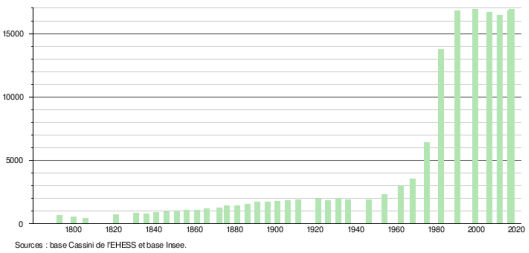
Histogram of demographic change
II.Natural Geography (environment and resources)
Cestas is a town in the South-West of France, located in the Gironde department, in the Nouvelle-Aquitaine region.

Municipality of the urban area of Bordeaux located in its urban unit in the Landes de Bordeaux, south-west of Bordeaux on the Eau Bourde.
Several bodies of water are scattered throughout the town, at Rousset by the motorway, at the Sources (Petit Trianon), two at Monsalut (old quarries) and a pond in the middle of 600 ha hectares of forests. The forest is mainly composed of pines and ferns. Three hiking parks are located there where dozens of kilometers of paths extend as well as 25 km of cycle paths.
Bordering municipalities: The neighboring municipalities are Pessac to the north, Canéjan to the north-east, Saucats to the south-east, Le Barp to the south-south-west, Mios to the south-west, Marcheprime to the west-south-west, Audenge to the extreme west, in quadripoint (point on the surface of the Earth which touches four distinct regions), and Saint-Jean-d'Illac to the north-west.
Geology, relief and hydrography:
The land is partly in sand from the Landes (fluvio-Aeolian formations of upper Pleistocene age), partly in gravel (gravel and pebbles deposited by the Garonne and mixed with sand or clay). Aliotic formations are frequently found between 1 m and 3 m in depth. The faluns outcrop on the side of the shore of the Eau Bourde.
The highest point, at an altitude of 80 m, is on the mound overlooking the Ribeyrot stream (small river, in Gascon). In 1737, the pyramid of Cassini was built on a hill 63 m high. Several IGN general leveling markers were set up around 1900 on buildings in Cestadais: that of the old town hall of Cestas is still in place, it indicates the level 47 m; that of the Gazinet annex town hall also, it indicates the level 52.10 m, like that of the Gazinet station (level 52.9 m). The terminal at 99, rue Jean Moulin à Gazinet was level 52.1 m. That of the church of Cestas no longer has its altitude indication. Another high point is at the site of the old Luc mill (Occitan toponym used for the sacred woods).
It is in Cestas that the Eau Bourde river takes its source; about twenty kilometers long it will flow into the Garonne near Bègles. The only tributary on the right bank is Le Ribeyrot, fed by many small streams including that of Marcouyau which joins Eau Bourde at a place called Les Couhours. The tributaries of the left bank are very numerous:
a)La Défuite, a ditch dug to drain the moor in the 17th century,
b)the Pas du Gros (formerly Craste de Serey) which joins it at the Moulin de la Moulette,
c)the Ruisseau de Monsalut fed by the Estey des Sources and its two tributaries, the Gleyses streams, which join it at the Pont des Amours, where the Eau Bourde changes direction and heads east,
d)the Ruisseau du Sérignan, to the north, which serves as a boundary with Canéjan.
Numerous small natural depressions called "lagoons", in water in winter, are found throughout the territory of the town.
The sanitary situation of the hydrographic network is monitored by the Adour-Garonne watershed information system.
Transport:
1)PROX'BUS:
Prox'Bus has its dedicated site: http://www.proxbus.fr
You will find all the plans and timetables.
Under the impetus of the Jalle Eau Bourde Community of Communes, the "Prox'Bus" local transport network has been modernized since September 1, 2016.
2)THE TRAIN
The Cestas Gazinet station (avenue de la gare) offers you the possibility of reaching Bordeaux Saint Jean station in a few minutes.
Gazinet station opening hours from September 1, 2018:
You can find these times under this link:
http://www.voyages-sncf.com
http://www.ter-sncf.com/aquitaine
For telephone information, dial 3635
3)THE TRAM
Do you want to take the tram? Thanks to the bus lines 602 (Cestas Pessac) and 505 (Cestas Gradignan Talence), you have the possibility of joining a tram station, or a park relay, if you use your vehicle
Find all the lines and timetables on the infotbc website to facilitate your trips.
http://www.infotbm.com
4)THE COACHES OF THE NEW AQUITAINE REGION
The coaches of the Nouvelle-Aquitaine region
The Nouvelle-Aquitaine Region offers a coach and mini bus service that will take you to:
From Canéjan and Cestas:
1)line 602: towards Pessac Bordeaux Unitec, where you can take the tram to Bordeaux
2)line 505: towards Gradignan, which will bring you to Talence Peixotto, where you can also take the tram.
From Saint Jean d´Illac:
1)line 601: towards Mérignac and Bordeaux, where you can take the tram to Bordeaux
Find all the lines and timetables to facilitate your trips
on https://www.transgironde.fr/ or on https://transports.nouvelle-aquitaine.fr/
Sources :https://www.mairie-cestas.fr/
https://www.mairie-cestas.fr/le-train/
https://www.mairie-cestas.fr/le-tramway/
https://www.mairie-cestas.fr/les-bus-de-transgironde/
III.Economy
Employment rate (%): 72.6 (2017)
Poverty rate by age group of the tax advisor(%): 5 (2017)
Average employment income (€):3 007 net per month (36 080 net per year)(2014)
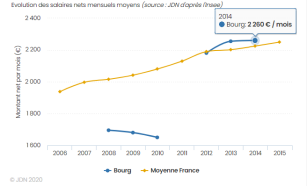
Evolution of average monthly net wages
Sources : http://www.journaldunet.com/business/salaire/cestas/ville-33122
https://insee.fr/fr/statistiques/2011101?geo=COM-33122
IV.Industrial Characterisitics
Contemporary economics:
In 2015, there were 900 companies spread over 5 activity areas:
Marticot industrial zone (new technologies, cutting-edge activities (Bordeaux Productic, Strycker, Lectra, ...))
The Auguste I, II, III, IV, V and Toctoucau activity zones (Scaso, Sucre d'Aquitaine, Agri33 ...)
Within the framework of the competences of the community of communes: activity zones Jarry, the Briquetterie, the Courneau and Pot au Pin.
In 1974, the old Béglaise unit of Alsacienne, created in 1880, moved to Gazinet under the name of LU: it accounts for 30% of Ceraliment production.
In November 2014, construction began on the Cestas solar power plant with a capacity of 300 MW, inaugurated on December 1, 2015. The largest photovoltaic power plant in Europe covers 260 hectares58. Established on a former forest area devastated during the 1999 storm, it consists of nearly a million solar panels and produces 350 gigawatt-hours per year, which makes it possible to meet the electricity needs of a population equivalent to the city of Bordeaux58. Its particularity consists of an east-west orientation of the solar panels, to optimize the capture of the sun's rays.
Large blocks of corn cultivation were opened in the Landes forest area following the fires of 1949. An anaerobic digestion unit supplied with intermediate crops for energy has been producing 125 Nm3 / h of biomethane since 2018.
Cestas photovoltaic solar power plant:
Peak power and energy production:
Twenty-five “small power plants” of 12 MWp are interconnected and connected to RTE's very high voltage network.
The plant has a power of 300 MWp for an estimated annual production of 350 GWh, which corresponds to the annual domestic consumption (excluding heating) of the entire municipality of Bordeaux (i.e. around 240,000 inhabitants), but less than 0.1% of French annual electricity production. This plant alone allows an increase of more than 6% in gross photovoltaic electricity production in France excluding overseas compared to 2014 production, which was 5,500 GWh.
At the time of its inauguration, it is the largest solar park in Europe. The plant has one million polycrystalline silicon modules.
Thanks to the east-west alignment of the photovoltaic modules, the production per hectare (of land and not of panels) is two to three times higher than that of a power plant of the same size oriented north-south, saving energy. 'space between rows of modules. Thus, the expected average power per unit area density is around 15 W / m2, compared to 3 to 8 W / m2 for other photovoltaic power plant projects in metropolitan France (Losse, Colle des Mées, Toul-Rosières, etc.) .
A unit of methanization is exclusively powered by cultures intermediaries, who are inserted in agricultural rotations of the operation.
Sources:https://www.actu-environnement.com/media/pdf/publireportages/environnement-et-technique/hors-serie-afg-gaz-vert-2020.pdf
V.Attractions
1.Church of Cestas
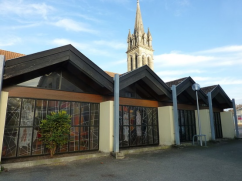
From the primitive Romanesque church, there remains a drawing dated 1744 showing an implantation overlooking the Eau Bourde stream, a description by Abbé Jaubert in his Dissertation on an octagonal temple and on several bas-reliefs found in Sestos and an 1871 plan drawn up before its demolition. The floor space was 177 m2. Five bas-reliefs framing the porch have been preserved and embedded in the outer wall of the apse of the current church.
Following the great plague epidemics, the church was dedicated to Saint Andrew. A brotherhood then formed, a statue of Saint Roch was given to the church in the seventeenth century in gratitude by the Cestadais during an epidemic of sheep plague (statue restored in 1995 and currently in the church).
In 1871, the building, considered too small, was not enlarged, but demolished. The construction of the new church (1873) is awarded at a discount to Sieur Goyetes; it was completed in 1875-76.
In 1911, a fire destroyed part of the interior and religious objects. The church was rehabilitated in 1912.
In 1982, Father Étienne Damoran being parish priest, the town hall and the parish decided to restore the three naves and to enlarge the church. This resolutely modern extension will be added to the left nave of the church. The old wooden doors of the portal are removed and replaced with glass doors. Christian Lacrampe is tasked by the mayor with monitoring the work with the architect Michel Sadirac.
The interior decoration uses only wood and bronze. The sculptures are by François Caldéron and Gérard Auliac. The figures of the original stained glass windows on the left side of the church, dating from the 19th century, are integrated after restoration into the modern stained glass windows assembled in old-fashioned lead. Jacques Fonmarty signed these stained glass windows at the expense of the parish. In 1989, the organ, out of breath, was replaced by an instrument produced by Yves Sévère and inaugurated in 1990.
2.Gazinet Chapel
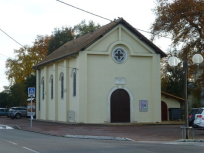
A chapel exists in Gazinet: it was used for worship until 1964 and then was desecrated. It was then used as a judo training room and a municipal painting workshop. In 1991, Pierre Ducout, then mayor of Cestas, decided to have this monument restored. The chapel is consolidated, repaired and equipped with new stained glass windows (Marcel Couture). It currently serves as a place of representation and exhibition and is used once a year for worship.
3.Chateau Haussmann
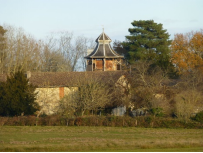
Baron Haussmann, a great architect renowned for the creation of the avenues of Paris and Bordeaux had a property in Cestas. It is located less than a kilometer from the village. He came there to rest and hunt. This castle actually belonged to his wife, Mlle de la Harpe. It was modern since in 1860 there was already running water. This castle is now private and cannot be visited (apart from a few schoolchildren). It was listed as a historical monument in 1975 and 1989.
VI.History
Contemporary period:
After the Hundred Years War, Cestas experienced a period of prosperity which saw the establishment of vines, woods and tileries (Gascon acts of 1481). But the wars of religion force many peasants to sell their land; around 1590, two families of lawyers in the Parliament of Bordeaux settled one in Monsalut (Sieurs De Lange) and the other in Fourcq (Sieurs Dupuy). Around 1620, two Relais de Poste were set up on the Spanish road, one in Lestaules and the other in Putz (Puch). The inventory on the death of the Postmaster of Lestaules Noël Taffart, in 1669, shows us the diversity of activities linked to the operation of one of these inns, and the economic benefits for local agriculture: vines, plowing, herds. sheep, beehives.
The economic and social life of the notables of Cestadais in the seventeenth century is known through the will and donations of Arnaud Hosten, ancestor of many families from Cestadais, who died on August 16, 1658.
In 1737, a pyramid was built on a motte to compensate for the absence of a bell tower or a fixed place in this area, in order to serve as a landmark in the triangulation of Cassini.
In the nineteenth century:
During the Revolution, the parish of Saint-André de Cestas formed the municipality of Cestas.
During his campaign towards Spain, Napoleon I slept with his troops in the forest of Cestas, at a place called Les Sources.
Gazinet-Cestas station was opened on May 7, 1841 by the Compagnie du chemin de fer de Bordeaux in La Teste. The tracks were electrified in June 1927.
The 1911 census indicates, out of 871 professions, almost half in agriculture, 10% in forestry trades (wood and resin) and as many in companies and brickyards as well as about twenty employees of the roads of iron of the South. It should also be noted that 38 laundresses receive a salary.
XXth century:
In 1829, L'Eau Bourde narrowly escaped a purchase by the city of Bordeaux to supply the fountain at Place Dauphine with quality drinking water.
In the summer of 1949, Cestas was devastated by the fire in the Landes forest, which spread over a large part of the Gironde. On August 20, 82 men were killed, firefighters, soldiers and inhabitants of the affected municipalities. A monument is dedicated to them.
In February 1969, Cestas also experienced the first publicized hostage-taking in France with the man who was then called the madman of Cestas. Between Monday February 3, 1969 and Monday February 17, a man, André Fourquet, 38, divorced from his wife, barricades himself in his house in the Sayet farm in Gazinet with his two children, Francis and Aline, aged respectively 11 and 13, the 14-year-old Chantale fled when her father warned they were all going to die. The man refuses the court decision which took away custody of the children in May 1968 and the gendarmes have already intervened three times when he kidnapped his children. While the police surround the farm, the mobile gendarme Jean-Lucien Carratala is killed by a bullet in the heart while he goes uncovered. Negotiations nevertheless continued for several days. Finally, when the gendarmes stormed with two half-tracks, Fourquet killed his two children with a bullet in the temple and shot himself in the mouth. During the funeral on February 20, Micheline Berton ex-Fourquet, the mother of the children, was taken to task and was almost lynched by part of the population who held her responsible for the tragedy for not wanting to see her ex-husband as he requested during the siege of the Sayet farm. Robert Enrico's film, Winter Fact, is directly inspired by this case. The eldest daughter, Chantal Fourquet, the only survivor, tried to have it banned.
In 1999 and 2009, Cestas was hit by two storms: "Lothar" on December 27, 1999 and, ten years later, Klaus on January 24, 2009. These two events caused a lot of damage, fortunately not human, but many pines fell. on the roads, temporarily blocking traffic and causing numerous blackouts.
VII.Other information
THE PARKS
1)WOODED SPACES
Discover unspoiled and wild nature. You will come across a wide variety of natural sites. There are many walking paths through which rivers and streams meander: Eau Bourde, Ribeyrot and Estey des Sources. They have small picnic areas (tables and benches), scattered throughout the forest.
a)Monsalut Park
b)The sources
c)The Fontanelles
d)The Ribeyrot
2)WATER BODIES
They are dedicated to fishing and relaxation, but swimming is prohibited there
a)Monsalut ponds
b)Estey des Sources
c)The Pinoche lake
d)The Rousset pond
3)FOREST PROTECTION
The DFCI publishes information documents on forest fire risk prevention for the general public.
Cestas has one of the largest forests in the department, it needs all the more to protect it
forest fire alert: sensitive and fragile, help protect it
The Landes de Gascogne forest is a pleasant living environment, but it is also a fragile natural environment which must be preserved and protected and which is the basis of an essential economic sector for our region.
clearing brush is not only a duty, but it is also an obligation. Know what it is, why it matters, where to do it, who needs to do it and how.
Sources : https://www.mairie-cestas.fr/les-parcs/
VIII.Contact information
Branne town hall address :
Cestas Town Hall
2 avenue Baron-Haussmann
33610 Cestas
Mayor : Pierre Ducout (Mandate : 2014-2020)
Mail: mairie.cestas@orange.fr
Phone number: 05 56 78 13 00
Fax: 05 57 83 59 64
Website : http://www.mairie-cestas.fr
Sources : http://www.cartesfrance.fr/carte-france-ville/33122_Cestas.html
